Well Control and Intervention
Controlling sabotaged oil wells in a war zone: Between Iraq and a hard spot
Non-standard wellhead configuration complicates high-volume blowout kill in Iraq’s south Rumalia oil fields
John Garner, Director of Engineering, Wellsure Division and William Markus, Safety Engineer, Boots & Coots
The war in Iraq commenced on March 20, 2003. In keeping with his past actions in Kuwait during the Gulf War in 1991, Saddam Hussein sabotaged a number of the Iraqi oil wells in the south Rumalia oil fields. Boots & Coots (B&C) entered into a contract to assist the military in controlling these wells at an unprecedented point in time, while the war was in full swing. Subsequently, B&C aided in extinguishing four wells which were on fire, and in safely controlling an additional five wells in the first 45 days of the war.
The following discussion describes stinging operations used to kill fires and well flow in Wells RU-67 and RU-64, which were flowing uncontrolled, the latter at up to 15,000 to 20,000 bopd.
CONDITIONS
Coalition forces advanced into Iraq to attack war zones soon after the war began. Meanwhile, convoys mobilized daily along the route from Kuwait city to the south Rumalia oil fields, before heading north to Basra and ultimately Baghdad. The main southern supply route for weapons and fuel passed close to three burning oil wells.
The sabotaged wells on fire emitted large billowing clouds of smoke and fumes that could be seen for hundreds of miles, Fig. 1. The desert sun further intensified conditions near the burning wells, while prevailing wind fueled the fire, spreading debris, smog and heat through the surrounding area.
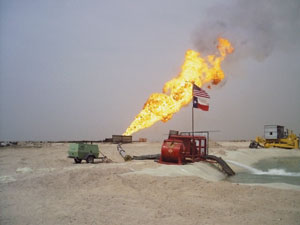 |
Fig. 1. South Rumalia Well RU64, initial blowout fire.
|
|
One well in particular was located within a few feet of the main road. During windy conditions, travel by this well was difficult; and completely stopping the convoy near this point would have subjected the vehicles to possible damage from smoke and radiant heat.
The Army Corp. of Engineers was tasked with making the convoy routes passable and safe. This assignment included extinguishing the burning oil wells. Initially, Coalition Forces infantry and the Kuwait Army secured a route in and out of the south oil fields to allow B&C fire pumps and heavy equipment to pass safely. Mobilization of the firefighting equipment, personnel and heavy equipment was simply the first of many challenges that awaited Boots & Coots.
PRE-PLANNING CHALLENGES
The lack of available drilling records and schematics for these wells created a problem in evaluating control options. The war caused Iraq Southern Oil Co. personnel to flee the area. For decades, Iraq's oil fields had been produced under strict Iraqi government control. Few outside companies worked with the wells in this area, so the strategies for control efforts had to be developed from other information resources. B&C personnel also relied on knowledge dealing with wells in nearby Kuwait.
Soon after the Iraq invasion of Kuwait in 1991, retreating Iraqi troops placed explosives on oil wells. Ultimately, Iraqi forces blew up more than 700 oil wells. B&C blowout specialists assisted in extinguishing wells in the Burgan fields. The last oil well blowout in Kuwait was capped on Nov. 8, 1991, in Northern Kuwait, some 8-1/2 months after the control work began. There were some 28 firefighting teams involved from the US, Canada, Kuwait, Iran, Hungary, Rumania, Russia and China. More than 70% of the blowouts were controlled by US teams. The firefighters called the effort ''Operation Desert Hell.''
Having experienced Hussein's massive destruction of oil wells first hand, B&C personnel were well aware of the methods of destruction and familiar with the scene of burning wells. But, what type of equipment and method of production had the Iraq Southern Oil Co. been using? And what were the production volumes and pressures prior to the blowouts? More important, in the middle of a desert, where would B&C find the large volume of water resources to extinguish the blazing oil wells?
RU-67: THE FIRST STING OPERATION
At the site of the first well, Kuwait Oil Co. dispatched firefighters to assist B&C in controlling the well, and simultaneously initiating response on another well. The cooperation enabled both teams to assist each other with logistics and resources.
For the teams, the first well proved hazardous. A well on fire and producing heavy black smoke is consistent with heavy-crude-oil production blowouts. Because of wellhead damage and the volume of burning oil, on-scene commanders decided to attempt a stinging operation, with the assistance of Halliburton Services from Kuwait.
The concept of stinging into an out-of-control well is not new, Fig. 2. In fact, the same procedure was utilized after the Gulf War at the Burgan fields in Kuwait. The team had to manufacture the specialized equipment to specific dimensions and tolerances. This capability required experts knowledgeable in uses and limitations of the stinger; but, first, the fire needed to be extinguished. This necessity brought up yet another logistical challenge: water.
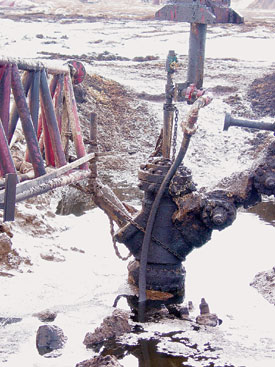 |
Fig. 2. South Rumalia Well RU 64, post- sting and kill operation.
|
|
Several water injection wells in the south Rumalia fields provided a possible solution, but the wells were not intended for the large volume necessary to extinguish an oil well fire. Further, the roads to the water wells were not designed for easy travel with large trucks.
To resolve the dilemma, the Baroid Co. of Kuwait offered its 130-bbl vacuum trucks to haul the water, and Halliburton supplied 500-bbl tanks for storage. Estimated turnaround time of the vacuum trucks for each load was about two hours. It took three days to fill the supply tanks with enough water for a single attempt at extinguishing a well.
While personnel filled supply tanks, the team set up fire pumps, monitor stands and other equipment for the stinging operation. Halliburton's crew prepared to pump the drilling mud through the stinger to kill the well once the fire was extinguished.
With preparations completed, operations began. A track hoe was walked into the blaze prior to fighting the fire and pulled the production head from the top of the well. The extraction of the production head removed the obstruction of the fire, allowing it to burn upward and vertical. This procedure cleared the view of the source and showed the target for the placement of the stinger.
As the blowout rate was relatively small, the firefight was quick and successful, only requiring a portion of the stored water, Fig. 3. Personnel then inserted the stinger using the Athey wagon. Attached to the stinger was high-pressure pipe that connected to a Halliburton pump truck delivering drilling mud. The truck pumped a necessary amount of drilling mud to control the well pressure through the pipe, killing the well. Once the pressure was eliminated, the team worked on the well to examine any damage and begin the repair process.
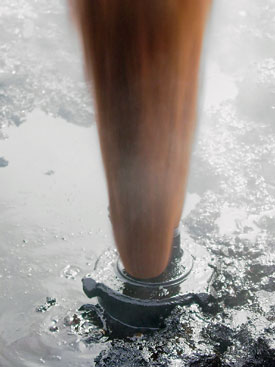 |
Fig. 3. South Rumalia Well RU 67, pre- sting and kill operation.
|
|
RU-64 BULLHEADING
With the blowout rate at a substantially larger volume, the second well tackled posed a different challenge, of greater concern than the first. The fire from Well 64 burned at a 45° angle, Fig. 1. The B&C team leader determined the casing valve had been damaged, but the production tree was still intact.
Preparations. The angle of the flame created a problem. The fire extended toward the road Coalition Forces used for the main supply route. If the team extinguished the fire, the unburned oil would run onto the road and spray vehicles driving by. The team leader estimated that while the well burned, it produced 10,000 bopd. The planning would have to include a fast solution for elimination of the flow of oil or a contingency for relighting the well if killing was not an immediate option.
The challenge of water supply remained a big concern. The well was larger than the first, producing more oil at a faster rate, through a bigger orifice. The crude oil produced was more flammable and more hazardous. These factors pointed to a longer fight with the fire and the necessity for more water.
B&C leaders decided on the need for a pit. Personnel designed and dug the pit to hold one million gallons of water, enough to extinguish the flames and cool down the surrounding area. The pit volume also required more trips to the water wells.
It took a team of trucks and personnel three full days to fill the pit to the required level, given the loss due to evaporation and leakage of the liner of about 3,000 gpd. Yet, in the end, the team collected sufficient water, equipment and personnel to sting and extinguish the well.
A bypass road was built through the desert around Well 64 to keep coalition forces and patrols from being soaked by oil. Dikes were also built around the well area and downhill to stop oil from flowing onto the road, which would have hampered travel and constant Coalition traffic.
Removing damaged surface valve and tree block. Once preparations were complete, the firefighting was initiated. The operation utilized 3,000 gpm of water from three monitor stands, and an effort by 10 B&C team members. The fire was extinguished in six hours, but the oil then discharged from the 7-1/16-in. casing valve for almost 500 yards, Fig. 4.
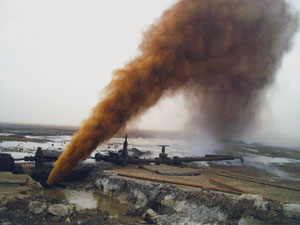 |
Fig. 4. South Rumalia Well RU 64, post- fire fight.
|
|
Upon inspection, it was discovered that damage to the wellhead left the 7-1/16-in. valve only partially intact, revealing some evidence of damage to the tubing head and possible damage to surface casing. These discoveries would lead the B&C team to postpone any kill scenarios until the wellhead was secure and ready. The decision to utilize Halliburton's abrasive cutting crew was made, to remove the damaged valve and the tree block for access to the 2-in. tubing and 7-1/16-in. casing. At this point, it was evident that the kill procedure on this well was not going to be as simple as the last one.
The estimated flowrate from the well, once the fire had been extinguished, was revised upward from the initial estimate, to 15,000 to 20,000 bopd. This daily volume, plus the concern of the 45° discharge angle and the proximity to the supply route, were all taken into consideration when designing a time table for the well-control procedure.
Boots & Coots and Halliburton spent the next day preparing the site for the abrasive jet cutter, and re-designing the work site for the many changes taking place. The concrete cellar was being broken out and access points were dug for the Athey wagon and jet cutter. Alternate equipment sites were prepared to cope with the ever-changing weather conditions that plague the area. The wind speed was excessive at times, blowing the light crude oil distances of a quarter mile or so. In addition to the speed, the wind frequently changed direction and, at times, blew the oil over the top of the work location, saturating equipment and personnel.
Not only was this a contamination issue, but the well was producing a light, very flammable oil that was in close proximity to hot exhaust and motors from equipment. Several times a day the entire site had to be evacuated and moved so fire would not become an additional hazard. The weather conditions, coupled with the reality of a war just to the north and Iraqi soldiers surrendering to the military on site, complicated preparing the site and setting up the jet cutter.
Refilling the pit remained a slow process. The oil was so flammable, relighting the well and extinguishing it when ready for the stinging operation were not viable options. If the well were relit and surface oil on the ground also reignited, the Coalition Forces' passage to the north would definitely be blocked. If the pit water supply could not be refilled the next day to extinguish the fire again, more delays in opening the road would be almost certain. B&C leaders decided to leave the well extinguished, continue refilling the fire water pit, and contain or divert any oil from the path of the convoys as necessary until the well was brought under control. After the cellar and site were prepared, Halliburton's abrasive jet cutter successfully removed the damaged valve, and the production tree down to the lower master valve.
Stinger use, well killing. Once the valve and upper production tree were removed, flow began exiting the 2-in. tubing but continued out the 7-1/16-in. valve at about the same rate as before. This possibility had been considered. However, flow subsiding from the 7-1/16-in. valve would have been more promising. A 1-in. by 4-in. stinger assembly was placed into the production line and attached to the high-pressure line from the Halliburton pump truck. Some 475 bbl of 12-ppg mud were pumped down the 2-in. line, at a rate of 9.5 bpm, at 1,200 psi. Flow from the casing valve slowed, but did not stop, indicating the tubing was possibly off bottom.
B&C then switched the stinger assembly to a larger, 5-in. by 8-in. stinger and placed it into the 7-1/16-in. casing valve at a 45° angle. After setting the stinger, 100 bbl of 12-ppg mud were pumped down the annulus, which slowed the flow significantly.
The next day, it was concluded that the circumstances required a bullhead operation from both the casing valve and tubing head to kill the well. By using two stingers, one in the casing valve and one in the tubing, both pumping mud under pressure, the bullhead technique would overcome the fluid and pressure simultaneously and allow the hydrostatic pressure developed to kill the well.
To prepare the well, a 2-in. by 4-in. stinger was rigged up on a track hoe and stung into the production tubing, Fig. 5. Water was pumped at 11 bpm, at 1,200 psi, to flush any gas buildup; it was then switched to 13-ppg mud. Pumping continued down the tubing with 120 bbl of 13-ppg mud, as flow from the casing valve started to subside.
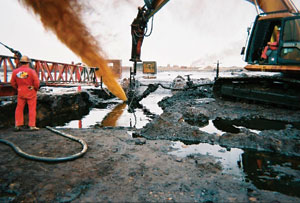 |
Fig. 5. South Rumalia Well RU 64, commencing sting- and- kill operation.
|
|
On the Athey wagon, the larger, 5-in. by 8-in. stinger was rigged up to a second pump truck, which then delivered 290 bbl of 13-ppg mud down the annulus. As the operation continued, the rate was reduced on the tubing as the pressure and rate was maintained on the annulus.
As pumping continued, B&C observed blow-by of oil diminish around the stinger/ wellhead interface and ultimately cease. Subsequently, observations of mud blow-by indicated that the bullheading operation was complete, with the wellbore full of mud, and pumping ceased. The stingers were opened to the atmosphere. A process of dual bullheading was continued intermittently throughout the day to ensure that the well remained static.
As the afternoon arrived and the order was given to return across the border to Kuwait, both stingers were closed and left in place to serve as temporary plugs, Fig. 2. The following morning found the well static on both 2-in. tubing and 7-1/16-in. casing – mission accomplished.
CONCLUSION
Boots & Coots accomplished the unprecedented task of killing all blowout wells in the first 45 days of an active war – where the wells were equipped with antiquated fittings, without access to wellbore schematics – and expeditiously accomplished such without personnel injuries or equipment loss. The well-control operations assisted the military in opening a crucial supply route to the north and reduced millions of dollars in loss of oil supply and production out of Iraq. The company continues to staff well control and blowout specialists in Iraq to assist in well-control prevention, response and security measures in Iraqi oil fields. 
THE AUTHORS
|
 |
John Garner, director of engineering, Boots & Coots WELLSURE Division, is responsible for all well control engineering operations of the WELLSURE Program, which is the proprietary insurance program that incorporates B&C expertise in blowout project management with control of well insurance underwritten by Lloyds of London. In addition, he served as senior well control engineer during the oil well fires of Iraq that occurred during the initial stages of the Iraqi invasion, March/ April 2003. He holds a BS degree in mechanical engineering from Texas A&M University and has over 23 years’ experience in drilling and petroleum production operations. Mr. Garner is a licensed professional engineer in Texas and is a member of ASME, SPE and AADE.
|
 |
William (Bill) Markus, senior safety engineer and well control specialist for Boots & Coots, has served as emergency response manager for numerous well control events, particularly associated with the WELLSURE Program. He has responded to blowouts in South America, the US and the Middle East. In addition, he served as senior safety engineer during the oil well fires of Iraq that occurred during initial stages of the Iraqi invasion, March/ April 2003. Mr. Markus holds numerous certifications in industrial firefighting command and control and has over 10 years’ experience in the emergency response industry.
|
| |
|
|









